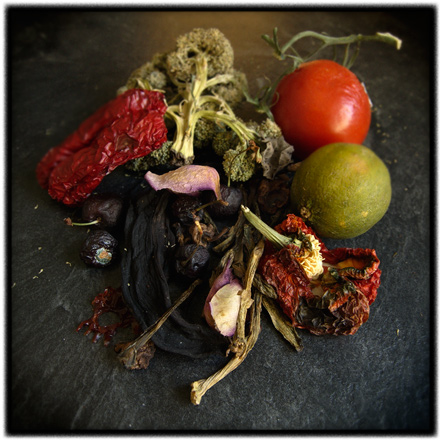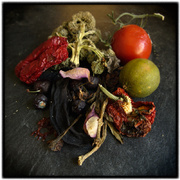still life # 6 ~ a medley
 Monday, January 28, 2008 at 09:27AM
Monday, January 28, 2008 at 09:27AM 

A medley of decay • click to embiggenAs I continue my still life and decay investigation / exploration, 2 'discoverys' have emerged from the proceedings.
1) Even if I try, I can't get way from visually complex 'compositions'.
2) Since my IKEA clip frame discovery, I have been making a picture, on average, every other day. Nothing new there, but what is new is that I am printing, clip framing, and wall mounting each new picture (and a few older ones) as I go. The realization that I have come to from this exercise is quite an epiphany - I used to think that the print was the thing but I have now come to realize that the print framed and mounted on a wall is an even better thing.
I photographed still life # 6 at around 8:45 this AM. By 10 AM it was framed and wall mounted.
What I am learning from this exercise is that if photography is the art of selecting what to picture (and how to picture it) and thus raising the referent to a higher level of 'importance', putting a framed picture on a wall helps greatly with the next level of 'selection'. Putting a picture on the wall elevates it once again to yet another level of 'importance'.
At this level of attention engendering 'importance', it becomes easier, at least for me, to relate to and 'judge' its ability to 'communicate' in a way that no screen viewing or even print in a portfolio can match.
Get framing people.

Reader Comments (5)
I couldn't agree more. Prints are for the viewing, framing and hanging makes this much the better for doing so.
I like your visually complex pictures. I've coined a term for this sort of style considered randomness. IMO, possibly the highest level of photographic art.
it's not enough to have withering vegetable on the kitchen counter...it is now hanging on the walls, too.
Even if I try, I can't get away from visually complex "compositions."
“As an example, it has been opined that Modernist American landscape photography was taken to it formal conclusion by Ansel Adams and Edward Weston. Their photography, which dazzles and seduces with technical and sensual qualities that aesthetically idealize the landscape, has been described as 'self-consciously photographic' and that it 'self-assuredly declares itself as art.'
“Translation - those guys worked their butts off (with malice of forethought aplenty) applying all of the traditional techniques of the medium - dramatic light, dramatic subjects, maximum dynamic range, smooth, sensuous, almost 'liquid' tonality, 'tight and clean' composition, maximum depth of field, etc. - to create prints of incomparable technical and aesthetic beauty that were obviously intended to be 'art'. Additionally, the hand of the maker is all over their photography - their is no mistaking an Ansel Adams' print. One could justifiably state that, with his prints, Adams drew as much attention (or more) to himself as he did to his subjects.
The above is lifted from your comments of a month or so ago on “random ditchiness.” Does not the effort involved to create a print worthy of mounting, matting, and framing immediately point to the conclusion that one should work one’s butt off in order create the print that best conveys the intent of the image (whether or not that includes the maximum dynamic range and any or all of the other items in your list above)? Admittedly, it is much easier today to get to that point in the digital world, vs the silver and selenium world of Ansel and Edward, but that is a different discussion altogether.
I absolutely agree with you about prints on the wall. I’ve been amazed at how much better a print looks when mounted than the exact same print did before it went into the dry mount press.
Funny, that tomato does not look so bad when compared to some of the other notes in your medley.
Does the print smudge or stick a little when pressed against the glass so soon after printing?
If I was going to the post office, and saw a really amazing Chrysler New Yorker parked in front of a small bungalow, and took a photo with a Holga, and made a print of a crappy flatbed scan at the local minilab, and put that print in an IKEA frame, then that piece of art on the wall would be no less valid than an Ansel Adams print. As long as the viewer could drop all of the baggage involved and just enjoy the image. Working one's butt off often helps, but it's only one way of thinking about how to make a great photograph.
Cheers,
Joe